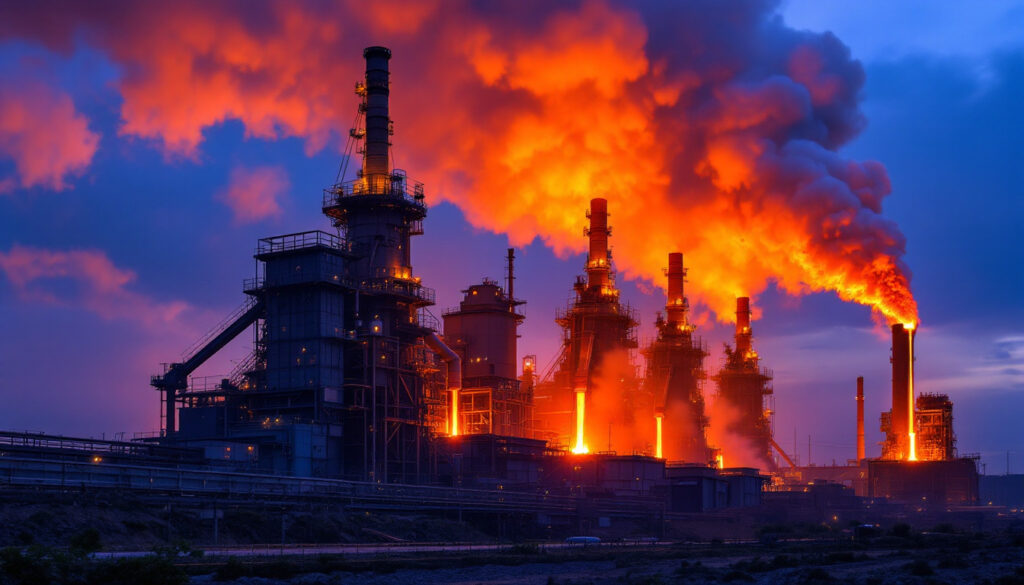Why Is China Cutting Steel Production in 2025?
China's steel industry faces a pivotal transformation as the world's largest producer signals significant production cuts for 2025. Baosteel, China's premier listed steelmaker, has indicated that nationwide reductions in steel output are becoming increasingly likely, sending ripples through global commodity markets and supply chains.
The anticipated cuts come amid mounting evidence that China's steel sector has reached a critical inflection point. Industry data reveals that despite Baosteel achieving a remarkable 26.4% year-on-year profit increase in Q1 2025, the broader market faces structural challenges that necessitate strategic production adjustments.
The Overcapacity Crisis in China's Steel Industry
China's steel industry has expanded dramatically over the past two decades, growing from producing about 15% of global steel in 2000 to commanding over 50% today. This explosive growth has created a significant imbalance between production capacity and actual domestic demand.
Market analysts estimate that China's annual steel production capacity exceeds 1 billion tonnes, while domestic consumption is projected to decline by approximately 2% in 2025. This widening gap between supply and demand has sparked concerns about industry sustainability and prompted government intervention.
According to Cai Yanbo, Baosteel's Deputy General Manager, "Chances for a cut are high as it has been mentioned in the government report." Industry sources reference market speculation around a potential 50 million tonne reduction in Chinese crude steel production for the coming year—equivalent to roughly 4.5% of the country's annual output.
The overcapacity situation is particularly challenging because China's economic growth model has shifted away from infrastructure-heavy development that previously absorbed massive steel volumes. As the economy matures, service sectors and higher-value manufacturing are taking precedence over construction and heavy industry.
Economic Factors Driving Production Cuts
Beyond domestic overcapacity, several key economic factors are accelerating the push toward production cuts:
Softening Domestic Demand: Construction activity, which accounts for approximately 55% of China's steel consumption, has slowed considerably following the property market downturn. This structural shift has contributed to the projected 2% decline in domestic steel consumption for 2025.
Rising Global Trade Barriers: Chinese steel exports, which reached a nine-year high of 110.72 million tonnes in 2024, face increasing resistance from international markets. According to Baosteel Chair Zou Jinxin, tariff increases in key export destinations will likely drive a 15 million tonne reduction in direct steel exports for 2025.
Environmental Policy Pressure: China's carbon reduction commitments have put energy-intensive industries like steel under greater scrutiny. Production cuts align with national environmental goals by potentially reducing the steel sector's substantial carbon footprint, which accounts for roughly 15% of China's industrial CO₂ emissions.
Manufacturing Sector Transformation: As China shifts toward higher-value manufacturing, the composition of steel demand is changing. More sophisticated steel grades are required, while overall volume requirements are decreasing in certain segments.
How Will Baosteel Implement Steel Production Reductions?
Baosteel's Strategic Approach to Output Cuts
While acknowledging the likelihood of industry-wide production cuts, Baosteel has articulated a nuanced position regarding implementation strategies. Yanbo has publicly appealed to relevant authorities to "avoid [a] one-size-fits-all approach while controlling output," suggesting that the company favors targeted reductions that consider efficiency, environmental performance, and product quality.
This stance reflects Baosteel's position as an industry leader with superior efficiency metrics and higher-value product offerings compared to many smaller producers. The company likely seeks to preserve its market share while supporting broader industry consolidation that would primarily impact less efficient competitors.
Yanbo further clarified that "immediate cuts were not anticipated," indicating a preference for gradual implementation that would allow supply chains to adjust. This measured approach aligns with Baosteel's historical tendency to advocate for market-based solutions rather than abrupt regulatory interventions.
Industry analysts note that Baosteel's strong financial position—evidenced by its 26.4% profit increase in Q1 2025—provides it with considerable flexibility to weather production adjustments. The company has invested heavily in operational efficiency, allowing it to maintain profitability even during periods of reduced output.
Potential Scale of Production Reductions
The speculated 50 million tonne nationwide production cut would represent approximately 4.5% of China's annual steel output. While significant, this reduction falls short of addressing the full extent of estimated overcapacity, suggesting that authorities may be pursuing a gradual, multi-year adjustment rather than a single dramatic intervention.
For context, China produced approximately 1.1 billion tonnes of crude steel in 2024, maintaining its position as the dominant global producer with over 50% of worldwide output. A 50 million tonne reduction would still leave China producing more than 1 billion tonnes annually—far exceeding the combined output of the next four largest producing nations.
Baosteel's specific production adjustment plans remain confidential, but industry experts anticipate that the company will focus on:
- Retiring older, less efficient production lines
- Increasing the share of high-value specialty steel products
- Maintaining capacity utilization rates above industry averages
- Developing export strategies focused on high-margin products less affected by tariffs
This strategic pivot would allow Baosteel to maintain revenue streams while complying with national production targets. The company's recent agreement with Marula Mining's Kenyan subsidiary for manganese ore supply indicates continued investment in securing high-quality raw materials despite production uncertainties.
What Impact Will Production Cuts Have on Global Steel Markets?
Effects on International Steel Pricing
A substantial reduction in Chinese steel output would likely help rebalance the global steel market, potentially supporting steel prices that have faced persistent downward pressure. Historical data demonstrates a clear correlation between Chinese production levels and global steel price movements.
When China implemented supply-side reforms between 2016 and 2017, reducing capacity by approximately 115 million tonnes, global hot-rolled coil prices increased by nearly 30%. While current market conditions differ, analysts suggest that a 50 million tonne cut could produce a price stabilization effect of 10-15% if implemented decisively.
The pricing impact would likely vary by product category:
- Construction steel: Potentially modest price increases (5-8%) due to continued domestic oversupply
- Automotive sheet: More significant price appreciation (12-15%) given higher value and tighter quality specifications
- Specialty steels: Limited direct impact as these products face less overcapacity issues
Price movements would also show regional variation, with markets more dependent on Chinese imports experiencing stronger effects. Southeast Asian markets, which absorbed nearly 30% of Chinese steel exports in 2024, would likely see the most immediate price response.
Changes to Global Steel Trade Patterns
Beyond direct price effects, the production cuts would catalyze significant shifts in global steel trade patterns. Zou Jinxin has projected that direct steel exports from China will decrease by approximately 15 million tonnes in 2025 due to tariff increases, representing a 13.5% reduction from 2024's nine-year peak of 110.72 million tonnes.
More surprisingly, Jinxin also noted that indirect steel exports—steel embedded in manufactured goods such as containers, vehicles, and machinery—would decrease by 20 million tonnes. This dual reduction signals a fundamental reshaping of China's position in global steel markets.
As Chinese exports recede, opportunities emerge for producers in other regions:
- India: Already expanding capacity aggressively, Indian steelmakers could accelerate export growth to Southeast Asian markets
- Japan and South Korea: May increase high-value automotive and appliance steel shipments to regions previously served by Chinese producers
- European producers: Potential to reclaim domestic market share previously lost to Chinese imports, particularly in specialty products
The reconfiguration of trade flows would likely develop gradually through 2025-2026, with market share shifts accelerating if Chinese production cuts extend beyond initial targets.
How Will Raw Material Suppliers Be Affected?
Implications for Iron Ore Markets
A 50 million tonne reduction in Chinese steel output would significantly impact iron ore demand, potentially reducing consumption by 75-80 million tonnes annually (based on typical yield ratios). This represents approximately 5% of global seaborne iron ore trade, creating substantial ripple effects throughout mining supply chains.
Major iron ore suppliers to China, including BHP, Rio Tinto, and Vale, would face varying degrees of exposure based on ore quality and contract structures. High-grade ore producers might experience less severe impacts if production cuts disproportionately affect mills using lower-grade inputs—a likely scenario given government preferences for maintaining more efficient operations.
Iron ore price forecasts under a 50 million tonne steel production cut scenario suggest:
- Short-term volatility as markets adjust to new demand parameters
- Medium-term price declines of 8-12% as supply exceeds revised demand forecasts
- Growing price premiums for higher-grade ores as mills prioritize efficiency
These dynamics could accelerate the existing iron ore price volatility with premium products maintaining value while lower-grade materials face more substantial price pressure.
Changes in Manganese and Coking Coal Demand
Beyond iron ore, production cuts would reshape markets for other steelmaking inputs, including manganese ore and coking coal. Baosteel's recent manganese supply contract with Marula Mining's subsidiary Muchai Mining Kenya demonstrates the company's continuing focus on securing critical raw materials despite production uncertainties.
The agreement to purchase manganese ore from Marula's Kenyan operations indicates Baosteel's strategic approach to diversifying supply sources while maintaining access to high-quality inputs. This suggests the company anticipates continued demand for premium steel products requiring specific raw material specifications, even amid broader production reductions.
Coking coal markets would experience similar quality-driven differentiation, with premium hard coking coals maintaining stronger demand compared to lower-quality thermal varieties. Australian producers, who supply approximately 60% of China's metallurgical coal imports, would face reduced overall demand but potentially stable pricing for premium products.
What Are the Broader Economic Implications?
Impact on China's Industrial Strategy
The anticipated steel production cuts align with China's broader economic policy goals of addressing industrial overcapacity and transitioning toward more sustainable growth models. Rather than representing an isolated sector adjustment, the reductions form part of a comprehensive industrial strategy reorienting the economy toward higher-value activities.
Zou Jinxin has indicated that additional government stimulus measures are expected to mitigate external economic challenges resulting from reduced steel production and exports. These initiatives would likely target:
- Infrastructure projects utilizing advanced construction methods requiring less steel
- Green energy investments creating new manufacturing opportunities
- Technology-intensive industries with higher profit margins than traditional steel-consuming sectors
- Domestic consumption enhancement to reduce export dependency
This multi-faceted approach aims to manage the economic transition while minimizing disruption to employment and regional economies heavily dependent on steel production. The government appears to be pursuing a balanced strategy that addresses overcapacity without triggering widespread industrial contraction.
Additionally, China's stimulus impact on various sectors will be crucial to monitor as the country navigates this industrial transformation.
Global Supply Chain Disruptions and Opportunities
A reduction in Chinese steel output and exports will necessitate adjustments throughout global supply chains. Manufacturers reliant on Chinese steel may need to secure alternative suppliers or adapt to changing price dynamics, potentially creating logistical challenges during the transition period.
Industries particularly sensitive to these changes include:
- Container manufacturing: China currently produces over 90% of global shipping containers, many utilizing domestically produced steel
- Automotive supply chains: Chinese steel is embedded in numerous vehicle components exported globally
- Construction equipment: Many global brands manufacture in China using local steel inputs
While these adjustments may create short-term disruptions, they also present opportunities for steel producers in other regions to capture market share previously dominated by Chinese suppliers. Companies that can rapidly expand capacity and meet quality requirements could benefit substantially from the realignment of global steel flows.
What Should Investors and Industry Stakeholders Monitor?
Key Indicators of Implementation Progress
Industry observers should closely track several metrics to gauge the effectiveness and pace of China's steel production cuts:
- Monthly crude steel output data: The most direct measure of compliance with reduction targets
- Capacity utilization rates: Declining rates would indicate genuine production cuts rather than temporary slowdowns
- Price movements: Sustained price increases would suggest successful market rebalancing
- Raw material import volumes: Declining iron ore and coking coal imports would confirm production reductions
- Policy announcements: Formal targets and implementation mechanisms from central authorities
The interplay between these indicators will provide a comprehensive view of how the production cuts are unfolding and their market impact. Initial signals would likely emerge in Q1-Q2 2025, with more definitive trends established by mid-year.
Notably, analysts are already observing an iron ore price surge in anticipation of potential stimulus measures that might offset some of the production cuts' impact.
Strategic Positioning for Different Market Participants
Various stakeholders in the steel value chain should consider specific strategic responses to the evolving landscape:
For raw material suppliers:
- Diversify customer base beyond China to mitigate demand uncertainty
- Develop premium product offerings that maintain value despite volume reductions
- Consider vertical integration opportunities as asset valuations adjust
For steel-consuming industries:
- Secure long-term supply agreements to hedge against potential price volatility
- Develop flexible sourcing strategies incorporating multiple regional suppliers
- Evaluate product redesigns that reduce steel intensity or utilize alternative materials
For competing steel producers:
- Assess capacity expansion opportunities targeting markets previously dominated by Chinese exports
- Develop specialty products addressing segments where Chinese competition is receding
- Form strategic partnerships to strengthen regional supply chains less dependent on Chinese inputs
These strategic adjustments would help industry participants navigate the transition period while positioning for longer-term opportunities in a rebalanced global steel market.
Looking ahead, participants should also consider how these changes align with broader industry trends, including mining and finance 2025 projections and mining decarbonisation trends that will shape the sector's future.
FAQ: China's Steel Production Cuts
How will these cuts affect global steel prices?
Production cuts of the magnitude being discussed (potentially 50 million tonnes) would likely help rebalance the market and provide support for steel prices. Based on historical correlations between Chinese production levels and global pricing, analysts project potential price increases of 10-15% for hot-rolled coil and similar products.
However, the impact would vary significantly by product category and region. Markets highly dependent on Chinese exports, particularly in Southeast Asia, would experience more substantial price effects. Meanwhile, specialty steel products and regions with strong domestic production might see more modest adjustments.
The timing of price responses would depend on implementation specifics, with gradual cuts likely producing more moderate, extended price appreciation rather than sudden spikes. Most analysts expect price stabilization effects to become evident within 3-4 months of implementation, assuming the cuts are meaningful and sustained.
Will other countries increase production to fill the gap?
Steel producers in other regions will certainly view China's production cuts as an opportunity to increase their market share, particularly in export markets previously dominated by Chinese suppliers. India, already the world's second-largest steel producer, has ambitious capacity expansion plans that could accelerate in response to Chinese reductions.
However, several factors will constrain how quickly and completely other producers can fill the gap:
- Capacity constraints: Few regions have significant unused capacity that could be immediately activated
- Capital requirements: New steel mills typically require 3-5 years from planning to full operation
- Quality specifications: Not all producers can meet the exacting standards required for automotive and appliance steels
- Logistics costs: Regional proximity advantages may limit which producers can competitively serve specific markets
While some production shifting will occur, particularly to India, Vietnam, and other Asian producers, the global market will likely experience a period of tighter supply before alternative capacity fully develops. This transition period could last 18-24 months, contributing to the price stabilization effects discussed earlier.
What does this mean for construction and manufacturing costs?
The impact on construction and manufacturing costs would vary significantly by sector, region, and steel intensity of the specific application. Generally, industries should prepare for:
- Modest cost increases: Steel typically represents 15-25% of structural construction costs, so even a 10% price increase would translate to 1.5-2.5% higher overall expenses
- Extended lead times: As supply chains adjust, temporary product availability issues may emerge for certain specifications
- Regional variations: Markets further from alternative steel sources may experience more significant price and availability challenges
Manufacturing sectors with high steel content—such as appliances, automotive, and heavy equipment—would face more substantial cost pressures than industries where steel represents a smaller input proportion. Companies with global sourcing capabilities would adapt more readily than those dependent on regional suppliers.
Forward-thinking firms are already developing mitigation strategies, including:
- Advance purchasing and inventory building
- Long-term supply agreements with price collars
- Product redesigns reducing steel intensity
- Alternative material substitution where feasible
How will this affect China's carbon emissions goals?
While not explicitly stated as a primary motivation for the cuts, reduced steel production would contribute significantly to China's carbon reduction targets. The steel industry accounts for approximately 15% of China's industrial carbon emissions, with each tonne of steel typically generating 1.8-2.0 tonnes of CO₂ (depending on production methods).
A 50 million tonne reduction in steel output could potentially eliminate 90-100
Looking to Leverage Early Mining Discovery Investments?
Discovery Alert's proprietary Discovery IQ model instantly identifies significant ASX mineral discoveries, providing subscribers with real-time trading and investment insights before the broader market reacts. Visit our discoveries page to explore historic returns from major mineral discoveries and begin your 30-day free trial today.




